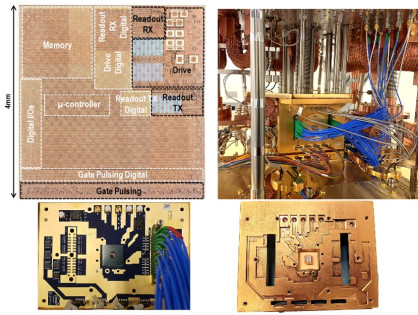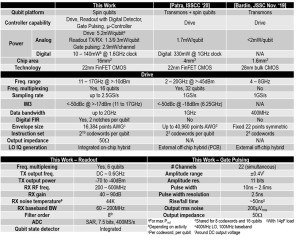Article By : Maurizio Di Paolo Emilio

Intel unveiled Horse Ridge II, its second-generation cryogenic control chip with the goal of overcoming the scalability of quantum systems.
During the 2021 International Solid-State Circuits Conference (ISSCC), Intel reported technical details for its second-generation cryogenic quantum control chip, Horse Ridge II, which puts careful team design work into practice with a combination of testing and technology development.
Quantum computing has the potential to solve problems that cannot be addressed via classical computing. However, its hardware complexity is still a challenge, limiting use on a commercial scale. During Intel Labs, Intel unveiled Horse Ridge II, its second-generation cryogenic control chip with the goal of overcoming the scalability of quantum systems. Intel has now provided more details, highlighting how Horse Ridge II optimizes circuit control, thereby harnessing the full potential offered by qubits while delivering higher fidelity and lower output power.
In an interview with EE Times, Stefano Pellerano, principal engineer at Intel Labs, noted “the challenge of scaling quantum systems elegantly as qubit numbers grow remains a daunting one and demands innovation in cryogenic control systems.” He added, “Horse Ridge II continues to build Intel’s vision of quantum practicality and bringing quantum from a lab to commercial reality.”

Cryogenic quantum control chips
Today’s quantum systems use room-temperature electronics, with many wires routed to the quantum processor located inside a dilution refrigerator. According to Intel and leading quantum computing proponents, this approach is inefficient because it does not scale with a large number of qubits due to size, cost, power consumption, and thermal load.
A radiator and fan cannot cool current quantum computers, and qubits must be kept inside large dilution refrigerators at temperatures just above absolute zero. Until now, the electronics needed to manipulate and read the qubits produced too much heat and thus had to stay outside the refrigerator, adding complexity to the system.
Making it all the more remarkable is the fact that the calculations take place using silicon spin qubits, which are particularly attractive to semiconductor manufacturers because they can be made using techniques already used in the production of traditional silicon chips.
A first study in 2020 by Intel and QuTech published in Nature has shown that they could control the so-called “hot qubits”, ensuring their operation at temperatures above 1 degree Kelvin (-272.15 degrees Celsius).
Silicon spin qubits, Intel’s technological effort in recent years, have properties such that they work at temperatures above one Kelvin, reducing the challenges of cryogenics.
Intel’s Horse Ridge II
With the first Horse Ridge release, Intel began to reduce sophisticated wiring by simplifying the rack architecture with a system-on-chip (SoC) that simplifies the design, improves qubit performance, and enables the engineering team to scale the quantum system to more qubits efficiently. Horse Ridge uses sophisticated signal processing techniques to accelerate setup time, improve performance and enable quantum systems to scale to more qubits.

Intel’s cryogenic control research focuses on achieving the same operating temperature level for both the controls and the silicon spin qubits.
Horse Ridge II is an SoC that builds on the first-generation controller’s ability to generate radio frequency pulses to manipulate the state of the qubit, known as qubit drive. It also introduces additional features that help with better integration of external electronic controls into the SoC operating inside the cryogenic refrigerator.
One key feature is called “multigate pulsing,” which is the ability to control the potential of many gates at the same time, facilitating readouts and coordinated operation of multiple qubits to achieve more scalable systems. Horse Ridge II can read the state of up to 6 qubits simultaneously, using RF single-electron transistor reflectometry. Reading qubits is done without storing large amounts of data, thus saving memory and power.
The control chip also features 22 high-speed digital-to-analog converters (DACs) to control the gate potentials of many qubits simultaneously. This is critical for efficient qubit readout, entanglement and multiple qubit operation.
The SoC contains more than 100 million transistors using Intel’s 22nm low-power FinFET (22FFL) technology. Intel engineers have verified the performance at 4 Kelvin (table 1).

The frequency multiplexing technique is the same as its predecessor, simplifying cabling and reducing the number of RF cables for qubit control, and providing a digital architecture to integrate into existing quantum control stacks.

Horse Ridge II can drive up to 16 spin qubits with a direct digital synthesis (DDS) architecture and an integrated digital filter for cross-talk mitigation to target an output frequency range of 11-17 GHz. Aiding the quantum processor is a microcontroller to provide the flexibility of algorithm execution (Figures 1 and 2).
Ongoing advances focus on scaling quantum interconnects that are a critical element of the long-term quantum practicality for any company that is working in quantum research. With Horse Ridge II, Intel wants to make quantum computers less complex and more practical with scalable interconnects. Intel pointed out that as the number of qubits increases, not dealing with the complexities of connecting them is like owning a sports car and being constantly stuck in traffic. Intel expects that Horse Ridge II will be able to offer higher fidelity and lower power consumption, bringing us closer to developing a scalable quantum computer.


